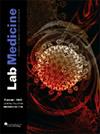Creating a Molecular Environment, Phase 4
IF 1
4区 医学
Q4 MEDICAL LABORATORY TECHNOLOGY
引用次数: 0
Abstract
When implementing molecular testing in the microbiology laboratory at OSF Saint Francis Medical Center, we started with the more difficult laboratory-developed testing and then moved to the United States Food and Drug Administration (FDA)–approved assays, which are equally important but require a less rigorous evaluation process. FDA-approved molecular testing can be less difficult because the assays in question have already been developed and validated. Our responsibility is to make sure that these assays work for our laboratory, write up the protocol with our specifications, and perform training before we turn out results on patients. Using FDA-approved testing usually involves following certain guidelines, which takes most of the guesswork out of the evaluation process. In 2007, the Illinois legislature passed a law known as the MRSA Screening and Report Act, which required all hospitals in Illinois to implement screening criteria for patients to determine whether they are carriers of methicillin-resistant Staphylococcus aureus (MRSA) on admission. This did not involve all patients but included those that were, according to the MRSA Screening and Report Act, “in all intensive care units, and other at-risk patients identified by the hospital”. OSF established guidelines for screening that have change slightly over the years. The most current screening criteria are as follows: [↵][1]* To whom correspondence should be addressed. E-mail: stephanie.e.wallace{at}osfhealthcare.org [1]: #xref-corresp-1-1创造分子环境,第四阶段
在OSF圣弗朗西斯医学中心的微生物学实验室实施分子检测时,我们从较困难的实验室开发的检测开始,然后转向美国食品和药物管理局(FDA)批准的检测,这些检测同样重要,但需要的评估过程不那么严格。fda批准的分子测试可能不那么困难,因为所讨论的分析已经被开发和验证。我们的责任是确保这些检测方法适用于我们的实验室,根据我们的规范编写协议,并在我们给患者提供结果之前进行培训。使用fda批准的测试通常需要遵循一定的指导方针,这就省去了评估过程中的大部分猜测。2007年,伊利诺斯州立法机关通过了一项被称为MRSA筛查和报告法案的法律,该法案要求伊利诺斯州的所有医院对患者实施筛查标准,以确定他们在入院时是否携带耐甲氧西林金黄色葡萄球菌(MRSA)。根据《MRSA筛查和报告法案》,这并不包括所有患者,但包括那些“在所有重症监护病房,以及医院确定的其他高危患者”。OSF建立的筛查指南多年来略有变化。最新的筛选标准如下:[[1]信函应寄给谁。电子邮件:stephanie.e.wallace{at}osfhealthcare.org [1]: #xref-corresp-1-1
本文章由计算机程序翻译,如有差异,请以英文原文为准。
求助全文
约1分钟内获得全文
求助全文
来源期刊

Labmedicine
医学-医学实验技术
CiteScore
2.50
自引率
0.00%
发文量
155
审稿时长
>12 weeks
期刊介绍:
Lab Medicine is a peer-reviewed biomedical journal published quarterly by the ASCP and Oxford University Press. The journal invites submission of manuscripts on topics related to clinical chemistry and microbiology, hematology, immunology, transfusion medicine, molecular diagnostics, cytology, histology, and laboratory administration and management. Original research, reviews, and case reports are considered for publication. Lab Medicine is indexed (under the title Laboratory Medicine) by the National Library of Medicine and is included in the PubMed database.
 求助内容:
求助内容: 应助结果提醒方式:
应助结果提醒方式:


